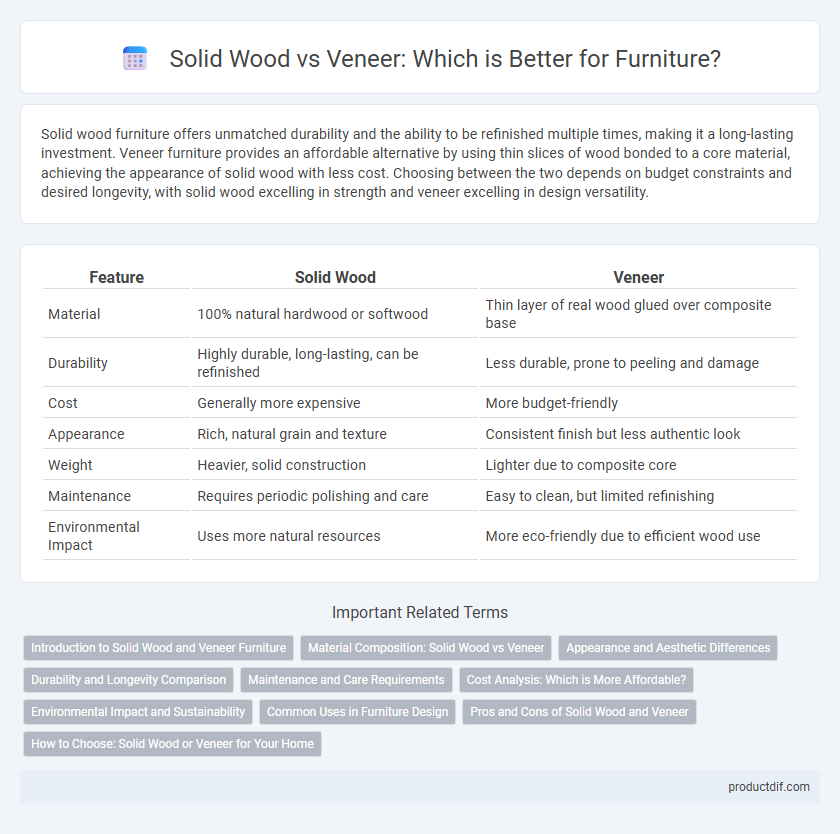Solid wood furniture offers unmatched durability and the ability to be refinished multiple times, making it a long-lasting investment. Veneer furniture provides an affordable alternative by using thin slices of wood bonded to a core material, achieving the appearance of solid wood with less cost. Choosing between the two depends on budget constraints and desired longevity, with solid wood excelling in strength and veneer excelling in design versatility.
Table of Comparison
| Feature | Solid Wood | Veneer |
|---|---|---|
| Material | 100% natural hardwood or softwood | Thin layer of real wood glued over composite base |
| Durability | Highly durable, long-lasting, can be refinished | Less durable, prone to peeling and damage |
| Cost | Generally more expensive | More budget-friendly |
| Appearance | Rich, natural grain and texture | Consistent finish but less authentic look |
| Weight | Heavier, solid construction | Lighter due to composite core |
| Maintenance | Requires periodic polishing and care | Easy to clean, but limited refinishing |
| Environmental Impact | Uses more natural resources | More eco-friendly due to efficient wood use |
Introduction to Solid Wood and Veneer Furniture
Solid wood furniture is crafted from natural, single pieces of timber, offering durability, unique grain patterns, and the ability to be refinished multiple times, making it a long-lasting investment. Veneer furniture uses thin slices of high-quality wood adhered to a core material like plywood or MDF, delivering an attractive wood appearance at a lower cost and with less environmental impact. Understanding the fundamental differences in construction and materials helps in choosing between the solid wood's authenticity and veneer's affordability.
Material Composition: Solid Wood vs Veneer
Solid wood furniture is crafted from a single piece of natural timber, offering durability, unique grain patterns, and the ability to be refinished multiple times. Veneer furniture consists of a thin layer of high-quality wood glued over a core of less expensive materials like plywood or MDF, providing an attractive surface at a lower cost. Solid wood tends to be heavier and more expensive, while veneer allows for diverse aesthetics and resistance to warping due to its engineered base.
Appearance and Aesthetic Differences
Solid wood furniture showcases natural grain patterns and unique textures, providing a rich, authentic appearance that deepens in character over time. Veneer furniture offers a more uniform and polished look by applying thin sheets of high-quality wood over cheaper substrates, allowing for diverse design options at a lower cost. While solid wood emphasizes durability and timeless beauty, veneer excels in achieving consistent aesthetics with intricate patterns that solid wood may not easily replicate.
Durability and Longevity Comparison
Solid wood furniture offers superior durability and longevity due to its natural strength and resistance to wear, often lasting decades with proper care. Veneer furniture, while more affordable and resistant to warping, tends to be less durable because its thin wood layer can chip or peel over time. Choosing solid wood ensures a longer-lasting investment, especially for high-traffic or heavy-use pieces.
Maintenance and Care Requirements
Solid wood furniture requires regular dusting, occasional polishing with natural oils, and protection from excessive moisture to prevent warping or cracking. Veneer furniture demands careful cleaning with a soft, damp cloth and avoidance of abrasive cleaners to maintain its thin wood layer and prevent peeling. Both types benefit from stable humidity levels and prompt attention to spills to preserve their appearance and longevity.
Cost Analysis: Which is More Affordable?
Solid wood furniture generally comes with a higher price tag due to the cost of raw materials and craftsmanship involved in shaping and finishing the wood. Veneer furniture is more affordable because it uses a thin layer of high-quality wood fused over less expensive materials, reducing both material and production expenses. For budget-conscious buyers seeking the look of real wood without the high cost, veneer offers a cost-effective alternative while solid wood appeals to those prioritizing durability and long-term value.
Environmental Impact and Sustainability
Solid wood furniture generally has a lower environmental impact due to its durability and potential for long-term reuse, reducing the need for frequent replacement. Veneer furniture uses thin slices of hardwood bonded to less sustainable core materials, which can lead to faster degradation and increased waste. Choosing solid wood from certified sustainably managed forests supports ecosystem health and promotes responsible forestry practices.
Common Uses in Furniture Design
Solid wood is commonly used in high-end furniture pieces such as dining tables, bed frames, and dressers due to its durability, strength, and natural aesthetic appeal. Veneer is often applied to furniture that requires a polished, uniform appearance like office desks, cabinets, and decorative panels while being more cost-effective and resistant to warping. Designers choose solid wood for structural and long-lasting projects, whereas veneer is preferred for intricate designs and budget-conscious production.
Pros and Cons of Solid Wood and Veneer
Solid wood furniture offers exceptional durability, natural beauty, and the ability to be refinished multiple times, making it a long-lasting investment; however, it is often more expensive and susceptible to warping or cracking due to humidity changes. Veneer furniture provides an affordable alternative with a wide variety of wood grain appearances and is less prone to environmental damage, but it tends to be less durable and cannot be refinished as easily, limiting its lifespan. Choosing between solid wood and veneer depends on budget, intended use, and desired longevity.
How to Choose: Solid Wood or Veneer for Your Home
Choosing between solid wood and veneer depends on durability, budget, and aesthetic preferences. Solid wood offers superior strength, longevity, and the ability to be refinished multiple times, making it ideal for heirloom-quality furniture. Veneer provides a cost-effective alternative with a wide range of wood grain appearances but is less durable and more susceptible to damage from moisture and wear.
Solid wood vs Veneer Infographic

 productdif.com
productdif.com